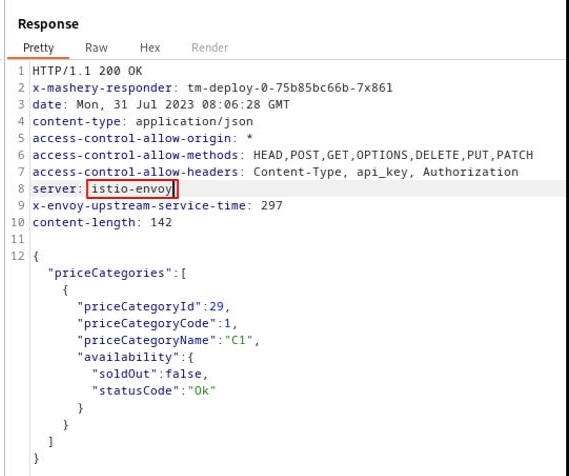En el panorama digital actual, donde las violaciones de datos y las amenazas cibernéticas se están volviendo cada vez más sofisticadas, garantizar la seguridad de sus servidores es primordial. Una de las preocupaciones críticas de seguridad que las organizaciones deben abordar es la «Divulgación de Información del Servidor». La Divulgación de Información del Servidor ocurre cuando información sensible sobre la configuración de un servidor, su pila tecnológica o estructura interna se expone inadvertidamente a partes no autorizadas. Los hackers pueden explotar esta vulnerabilidad para obtener información sobre posibles puntos débiles y lanzar ataques dirigidos. Tales violaciones pueden llevar al robo de datos, interrupción del servicio y daño a la reputación.
Divulgación de Información y Malla de Servicios Istio
Un ejemplo es el Encabezado HTTP del Servidor, que generalmente se incluye en la mayoría de las respuestas HTTP donde se encuentra el servidor que está proporcionando esta respuesta. Los valores pueden variar dependiendo de la pila, pero asuntos como Jetty, Tomcat o similares suelen verse. Pero también, si está utilizando una Malla de Servicios como Istio, verá el encabezado con un valor de istio-envoy, como puede ver aquí:

Como se comentó, esto es de tal importancia para varios niveles de seguridad, tales como:
- Privacidad de Datos: La fuga de información del servidor puede exponer datos confidenciales, socavando la confianza del usuario y violando regulaciones de privacidad de datos como GDPR y HIPAA.
- Reducción de la Superficie de Ataque: Al ocultar los detalles del servidor, minimiza la superficie de ataque disponible para posibles atacantes.
- Seguridad por Oscuridad: Aunque no es un enfoque infalible, limitar la divulgación agrega una capa extra de seguridad, dificultando que los hackers recopilen información.
¿Cómo mitigar eso con la Malla de Servicios Istio?
Al usar Istio, podemos definir diferentes reglas para agregar y eliminar encabezados HTTP según nuestras necesidades, como puede ver en la siguiente documentación aquí: https://discuss.istio.io/t/remove-header-operation/1692 usando cláusulas simples para la definición de su VirtualService como puede ver aquí:
apiVersion: networking.istio.io/v1alpha3
kind: VirtualService
metadata:
name: k8snode-virtual-service
spec:
hosts:
- "example.com"
gateways:
- k8snode-gateway
http:
headers:
response:
remove:
- "x-my-fault-source"
- route:
- destination:
host: k8snode-service
subset: version-1
Desafortunadamente, esto no es útil para todos los encabezados HTTP, especialmente los «principales», por lo que los que no son personalizados agregados por sus cargas de trabajo, sino los que son principalmente utilizados y definidos en el estándar HTTP W3C https://www.w3.org/Protocols/
Entonces, en el caso del encabezado HTTP del Servidor es un poco más complejo de hacer, y necesita usar un EnvoyFilter, uno de los objetos más sofisticados que forma parte de la Malla de Servicios Istio. Basado en las palabras de la documentación oficial de Istio, un EnvoyFilter proporciona un mecanismo para personalizar la configuración de Envoy generada por Istio Pilot. Por lo tanto, puede usar EnvoyFilter para modificar valores para ciertos campos, agregar filtros específicos o incluso agregar nuevos oyentes, clústeres, etc.
Implementación de EnvoyFilter para Eliminar Encabezado
Así que ahora que sabemos que necesitamos crear un EnvoyFilter personalizado, veamos cuál necesitamos usar para eliminar el encabezado del Servidor y cómo se hace esto para obtener más conocimiento sobre este componente. Aquí puede ver el EnvoyFilter para ese trabajo:
---
apiVersion: networking.istio.io/v1alpha3
kind: EnvoyFilter
metadata:
name: gateway-response-remove-headers
namespace: istio-system
spec:
workloadSelector:
labels:
istio: ingressgateway
configPatches:
- applyTo: NETWORK_FILTER
match:
context: GATEWAY
listener:
filterChain:
filter:
name: "envoy.filters.network.http_connection_manager"
patch:
operation: MERGE
value:
typed_config:
"@type": "type.googleapis.com/envoy.extensions.filters.network.http_connection_manager.v3.HttpConnectionManager"
server_header_transformation: PASS_THROUGH
- applyTo: ROUTE_CONFIGURATION
match:
context: GATEWAY
patch:
operation: MERGE
value:
response_headers_to_remove:
- "server"
Así que centrémonos en las partes de la especificación del EnvoyFilter donde podemos obtener por un lado el usual workloadSelector, para saber dónde se aplicará este componente, que en este caso será el istio ingressgateway. Luego entramos en la sección configPatches, que son las secciones donde usamos la personalización que necesitamos hacer, y en nuestro caso, tenemos dos de ellas:
Ambas actúan en el contexto: GATEWAY y se aplican a dos objetos diferentes: NETWORK_FILTER Y ROUTE_CONFIGURATION. También puede usar filtros en sidecars para afectar su comportamiento. La primera parte lo que hace es incluir el filtro personalizado http_connection_manager que permite la manipulación del contexto HTTP, incluyendo para nuestro propósito principal también el encabezado HTTP, y luego tenemos la segunda parte que actúa en el ROUTE_CONFIGURATION eliminando el encabezado del servidor como podemos ver usando la opción response_header_to_remove
Conclusión
Como puede ver, esto no es fácil de implementar. Sin embargo, al mismo tiempo, es evidencia del poder y las capacidades de bajo nivel que tiene al usar una malla de servicios robusta como Istio para interactuar y modificar el comportamiento de cualquier pequeño detalle que desee para su beneficio y, en este caso, también para mejorar y aumentar la seguridad de sus cargas de trabajo desplegadas detrás del alcance de la Malla de Servicios.
En el panorama en constante evolución de las amenazas de ciberseguridad, proteger sus servidores contra la divulgación de información es crucial para proteger datos sensibles y mantener la integridad de su organización. Istio le permite fortalecer la seguridad de su servidor al proporcionar herramientas robustas para la gestión del tráfico, el cifrado y el control de acceso.
Recuerde, la clave para una seguridad adecuada del servidor es un enfoque proactivo que aborde las vulnerabilidades antes de que puedan ser explotadas. Tome la iniciativa de implementar Istio y eleve la protección de su servidor.




